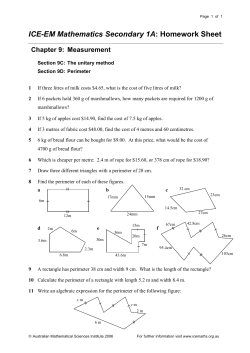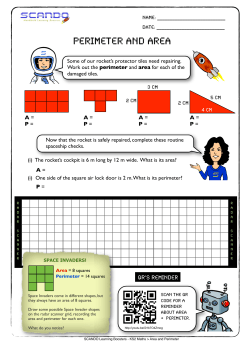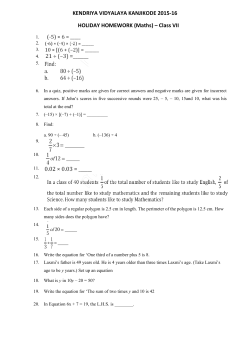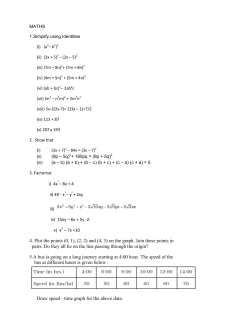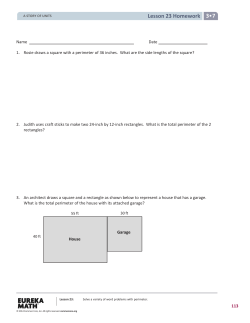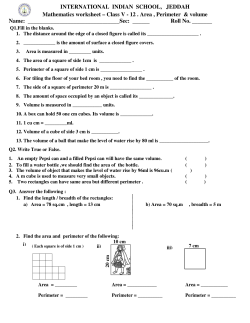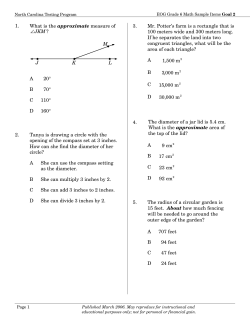
You Can Grow Your Brain - Pathfinder K
!"#$%&'$()"*$!"#)$+)&,'$
!"#$%"&"'()*$+*,#&$-*"$.('/0$1'0$."$2"3"4,5"6$7/8"$'$9:&)4"$
&
&
5236&7,078,&9:;3<&0=&9:,&>?2;3&2.&2&@6.9,?6A&&B,&C03D9&0=9,3&9:;3<&2>019&-:29&
;39,88;E,3F,&;.&0?&:0-&;9&-0?<.A&C&-:,3&601&C0&9:;3<&2>019&-:29&
;39,88;E,3F,&;.G&601&@;E:9&9:;3<&9:29&2&7,?.03&;.&>0?3&,;9:,?&.@2?9G&2H,?2E,G&0?&
C1@>I,;9:,?&2&J@29:&7,?.03K&0?&309I23C&.926.&9:29&-26&=0?&8;=,A&
&
L19&3,-&?,.,2?F:&.:0-.&9:29&9:,&>?2;3&;.&@0?,&8;<,&2&@1.F8,I;9&F:23E,.&23C&
E,9.&.9?03E,?&-:,3&601&1.,&;9A&&(F;,39;.9.&:2H,&>,,3&2>8,&90&.:0-&M1.9&:0-&9:,&
>?2;3&E?0-.&23C&E,9.&.9?03E,?&-:,3&601&
8,2?3A&&
&
"H,?603,&<30-.&9:29&-:,3&601&8;=9&-,;E:9.G&
601?&@1.F8,.&E,9&>;EE,?&23C&601&E,9&.9?03E,?A&&
#&7,?.03&-:0&F23D9&8;=9&NO&7013C.&-:,3&9:,6&
.92?9&,P,?F;.;3E&F23&E,9&.9?03E&,301E:&90&8;=9&
QOO&7013C.&2=9,?&-0?<;3E&019&=0?&2&803E&9;@,A&&
%:29D.&>,F21.,&@1.F8,.&>,F0@,&82?E,?&23C&.9?03E,?&-;9:&,P,?F;.,A&C&-:,3&
601&.907&,P,?F;.;3EG&9:,&@1.F8,.&.:?;3<&23C&601&E,9&-,2<,?A&%:29D.&-:6&
7,078,&.26&J4.,&;9&0?&80.,&;9RK&
&
L19&@0.9&7,078,&C03D9&<30-&9:29&-:,3&9:,6&7?2F9;F,&23C&8,2?3&3,-&9:;3E.G&
72?9.&0=&9:,;?&>?2;3&F:23E,&23C&E,9&82?E,?G&2&809&8;<,&9:,&@1.F8,.&C0A&&%:;.&;.&
9?1,&,H,3&=0?&2C189.A&&(0&;9D.&309&9?1,&9:29&.0@,&7,078,&2?,&.91F<&>,;3E&J309&
.@2?9K&0?&J309&@29:&7,078,AK&&/01&F23&;@7?0H,&601?&2>;8;9;,.&2&809G&2.&803E&2.&
601&7?2F9;F,&23C&1.,&E00C&.9?29,E;,.A&
&
*3.;C,&9:,&019.;C,&826,?&0=&9:,&>?2;3IF288,C&9:,&
F0?9,PI2?,&>;88;03.&0=&9;36&3,?H,&F,88.G&F288,C&
3,1?03.A&&%:,&3,?H,&F,88.&:2H,&>?23F:,.&
F033,F9;3E&9:,@&90&09:,?&F,88.&;3&2&F0@78;F29,C&
3,9-0?<A&&)0@@13;F29;03&>,9-,,3&9:,.,&>?2;3&
F,88.&;.&-:29&2880-.&1.&90&9:;3<&23C&.08H,&7?0>8,@.A&
&
!"#$%!&'&()*"+)"&+,-.&/01&)23&4.,&
B:,3&601&8,2?3&3,-&9:;3E.G&9:,.,&9;36&F033,F9;03.&;3&9:,&>?2;3&2F912886&
@189;786&23C&E,9&.9?03E,?A&&%:,&@0?,&601&F:288,3E,&601?&@;3C&90&8,2?3G&9:,&
@0?,&601?&>?2;3&F,88.&E?0-A&&&
&
%:,3G&9:;3E.&9:29&601&03F,&=013C&H,?6&:2?C&
0?&,H,3&;@70..;>8,&90&C0I8;<,&.7,2<;3E&2&
=0?,;E3&823E12E,&0?&C0;3E&28E,>?2I
>,F0@,&,2.;,?A&&%:,&?,.189&;.&2&.9?03E,?G&
.@2?9,?&>?2;3A&
$
;,#$2,$<"$=0,#$>*'-$>*"$.('/0$1'0$?(,#$+-(,0@"(A$
(F;,39;.9.&.92?9,C&9:;3<;3E&9:,&:1@23&>?2;3&F018C&C,H,807&23C&F:23E,&-:,3&
9:,6&.91C;,C&2C189&23;@28.D&>?2;3.A&&%:,6&=013C&9:29&23;@28.&-:0&8;H,C&;3&2&
F:288,3E;3E&,3H;?03@,39G&-;9:&09:,?&23;@28.&23C&906.&90&7826&-;9:G&-,?,&
C;==,?,39&=?0@&23;@28.&-:0&8;H,C&2803,&;3&>2?,&F2E,.A&
&
B:;8,&9:,&23;@28.&-:0&8;H,C&2803,&M1.9&29,&23C&.8,79&288&9:,&9;@,G&9:,&03,.&-:0&
8;H,C&-;9:&C;==,?,39&906.&23C&09:,?&23;@28.&-,?,&28-26.&2F9;H,A&&%:,6&.7,39&2&
809&0=&9;@,&=;E1?;3E&019&:0-&90&1.,&9:,&906.&23C&:0-&90&E,9&2803E&-;9:&09:,?&
23;@28.A&
&
%:,.,&23;@28.&:2C&@0?,&F033,F9;03.&>,9-,,3&9:,&
3,?H,&F,88.&;3&9:,;?&>?2;3.A&&%:,&F033,F9;03.&-,?,&
>;EE,?&23C&.9?03E,?G&900A&&*3&=2F9G&9:,;?&-:08,&
>?2;3.&-,?,&2>019&QOS&:,2H;,?&9:23&9:,&>?2;3.&0=&
9:,&23;@28.&-:0&8;H,C&2803,&-;9:019&906.A&
&
%:,&2C189&23;@28.&-:0&-,?,&,P,?F;.;3E&9:,;?&
>?2;3.&>6&7826;3E&-;9:&906.&23C&,2F:&09:,?&-,?,&
28.0&J.@2?9,?K&T9:,6&-,?,&>,99,?&29&.08H;3E&
7?0>8,@.&23C&8,2?3;3E&3,-&9:;3E.A&
&
1'0$B6:4-&$?(,#$>*"/($.('/0&A&
(F;,39;.9.&:2H,&?,F,3986&.:0-3&9:29&2C189.&F23&E?0-&9:,&72?9.&0=&9:,;?&>?2;3.&
9:29&F039?08&9:,;?&2>;8;9;,.I8;<,&9:,&2>;8;96&90&C0&@29:&0?&,H,3&90&M1EE8,A&
&
*3&03,&.91C6G&.F;,39;.9.&=013C&2&E?017&0=&2C189.&-:0&-,?,&309&M1EE8,?.A&&&%:,6&
921E:9&:28=&:0-&90&7?2F9;F,&M1EE8;3E&;3&9:,&?;E:9&-26A&&%:,.,&7,078,&7?2F9;F,C&
!"#$%!&'&()*"+)"&+,-.&/01&)23&4.,&
=0?&2&803E&9;@,&23C&E09&@1F:&>,99,?&29&M1EE8;3EA&&%:,&09:,?&:28=&C;C3D9&7?2F9;F,G&
23C&C;C3D9&E,9&>,99,?A&&&
&
+,P9G&9:,&.F;,39;.9.&1.,C&2&>?2;3&.F233,?&90&F0@72?,&9:,&>?2;3.&0=&9:,&9-0&
E?017.&0=&7,078,A&&%:,6&=013C&9:29&9:,&7,078,&-:0&8,2?3,C&:0-&90&M1EE8,&
2F912886&E?,-&9:,&72?9.&0=&9:,;?&>?2;3.&9:29&F039?08&M1EE8;3E&.<;88.I9:,&H;.128&
23C&@090?&2?,2.A&&%:,;?&>?2;3.&:2C&F:23E,CG&.0&9:,6&2F912886&:2C&@0?,&2>;8;96A&
&
%:;.&-2.&.1?7?;.;3E&>,F21.,&9:,.,&7,078,&
.2;C&>,=0?,&9:,&.91C6&9:29&9:,6&F018C3D9&
M1EE8,IM1.9&8;<,&.0@,&7,078,&.26&9:,6D?,&
J309&E00C&29&@29:AK&&L19&-:,3&9:,6&8,2?3,C&
E00C&.9?29,E;,.&=0?&7?2F9;F;3E&23C&<,79&
9?6;3EG&9:,6&2F912886&8,2?3,C&23C&E?,-&
!"#$%&&'()#*+,-.#'/#-0%#1,+2"#-0+-#
9:,;?&>?2;3.A&&&&
3,%(#(0%"#+45&-.#&%+,"%4#-'#
&
6533&%#
%:;.&F23&:277,3&>,F21.,&8,2?3;3E&F21.,.&
&
C0;VQOAQWXQYM01?328A703,AOOONZZ[AEOOQ#
7,?@23,39&F:23E,.&;3&9:,&>?2;3A&&%:,&
M1EE8,?.D&>?2;3&F,88.&E,9&82?E,?&23C&E?0-&
3,-&F033,F9;03.&>,9-,,3&9:,@A&&%:,.,&3,-G&.9?03E,?&F033,F9;03.&@2<,&9:,&
M1EE8,?D.&>?2;3&.9?03E,?&23C&.@2?9,?G&M1.9&8;<,&2&-,;E:98;=9,?D.&903,C&@1.F8,.A&
$
B$C,(D:4'$C,($?(,#/0@$E,:($F9'-*$.('/0GH$
IJJ,(-$K$?,,6$+-('-"@/"&$K$;"45$C(,D$L-*"(&$
&
(F;,39;.9.&:2H,&28.0&=013C&9:29&8,2?3;3E&90&M1EE8,&;.&2&809&8;<,&E,99;3E&>,99,?&29&
@29:A&&B:,3&7,078,&8,2?3&23C&7?2F9;F,&3,-&-26.&0=&C0;3E&28E,>?2&0?&.929;.9;F.G&
;9&F23&E?0-&9:,;?&>?2;3.I,H,3&;=&9:,6&:2H,3D9&C03,&-,88&;3&@29:&;3&9:,&72.9A&&&
&
(9?,3E9:,3;3E&9:,&J@29:K&72?9&0=&601?&>?2;3.&1.12886&:277,3.&-:,3&601&9?6&
:2?C&03&F:288,3E;3E&@29:&7?0>8,@.A&&L19&;9D.&309&M1.9&2>019&,==0?9A&&/01&28.0&
3,,C&90&8,2?3&.<;88.&9:29&8,9&601&1.,&601?&>?2;3&;3&2&.@2?9,?&-26A&&&
&
*=&601&1.,&2&>2C&.9?29,E6G&601&@26&309&8,2?3I,H,3&;=&601&9?6&:2?CA&&#&=,-&
7,078,&.91C6&=0?&@29:&>6&C0;3E&9:,&.2@,&.,9&0=&,2.6&7?0>8,@.&23C&.<;77;3E&
9:,&:2?C&03,.G&0?&M1.9&?,U?,2C;3E&9:,&9,P9>00<G&>,F21.,&;9&=,,8.&,2.;,?A&&/,9&
-:,3&;9&F0@,.&9;@,&90&C0&9:,&9,.9G&9:,6&C03D9&C0&-,88&>,F21.,&9:,6&C;C3D9&-0?<&
03&7?0>8,@.&9:29&.9?,9F:,C&9:,;?&>?2;3.&23C&921E:9&9:,@&3,-&9:;3E.A&&B:,3&
9:;.&:277,3.G&9:,6&@26&,H,3&.26&J*D@&M1.9&309&.@2?9&29&@29:AK&&&
!"#$%!&'&()*"+)"&+,-.&/01&)23&4.,&
&
L19&9:,&9?19:&;.&9:29&,H,?603,&F23&>,F0@,&.@2?9,?&29&@29:&;=&9:,6&7?2F9;F,&;3&
9:,&?;E:9&-26A&*=&2&-,;E:9&8;=9,?&-29F:,C&09:,?&7,078,&,P,?F;.,&288&C26&803EG&:,&
-018C3D9&E,9&236&.9?03E,?A&C&;=&.0@,03,&9?;,C&90&8,2?3&:0-&90&M1EE8,&>6&M1.9&
?,2C;3E&2&>00<&2>019&M1EE8;3EG&9:,6&-018C3D9&8,2?3A&/01&2F912886&:2H,&90&
7?2F9;F,&9:,&?;E:9&-26I23C&1.12886&9:29&@,23.&9:,&:2?C&-26I90&E,9&>,99,?&29&
.0@,9:;3EA&&*3&=2F9G&.F;,39;.9.&:2H,&=013C&9:29&9:,&>?2;3&E?0-.&@0?,&-:,3&601&
8,2?3&.0@,9:;3E&3,-G&23C&8,..&-:,3&601&7?2F9;F,&9:;3E.&601&28?,2C6&<30-A&&
&
%:;.&@,23.&9:29&;9D.&309&M1.9&:0-&@1F:&9;@,&23C&,==0?9&601&719&;3&90&.91C6;3E&
@29:G&>19&-:,9:,?G&-:,3&601&.91C6G&601&8,2?3&.0@,9:;3E&3,-&23C&:2?CA&&%0&
C0&9:29G&601&1.12886&3,,C&90&1.,&9:,&?;E:9&.9?29,E;,.A&&\,078,&0=9,3&8,2?3&9:0.,&
E00C&.9?29,E;,.&=?0@&09:,?.G&8;<,&9,2F:,?.&0?&.91C,39.&-:0&C0&-,88A&&$1F<;86G&
.9?29,E;,.&2?,&,2.6&90&8,2?3&;=&601&E,9&:,87A&
&
>*"$>(:-*$BM,:-$F+D'(-G$'06$F2:DMG$
$
\,078,&2?,3D9&J.@2?9K&0?&JC1@>K&29&@29:A&	&=;?.9G&30&03,&F23&?,2C&0?&.08H,&
,]129;03.A&&L19&-;9:&7?2F9;F,G&9:,6&F23&8,2?3&90&C0&;9A&C&9:,&@0?,&2&7,?.03&
8,2?3.G&9:,&,2.;,?&;9&E,9.&90&8,2?3&3,-&9:;3E.I>,F21.,&9:,;?&>?2;3&J@1.F8,.K&
:2H,&E099,3&.9?03E,?A&&
&
%:;.&;.&9?1,&,H,3&=0?&2C189.&-:0&:2H,&.9?1EE8,C&=0?&2&803E&9;@,&90&8,2?3&
.0@,9:;3EA&&^?A&B;99,3>,?EG&2&.F;,39;.9&=?0@&B2<,&_0?,.9&43;H,?.;96G&.2;C&JB,&
1.,C&90&9:;3<&2C189.&F23D9&=0?@&3,-&>?2;3&F033,F9;03.G&>19&30-&-,&<30-&9:29&
;.3D9&9?1,`&%:,&2C189&>?2;3&;.&8;<,&2&@1.F8,G&23C&-,&3,,C&90&,P,?F;.,&;9AK&
$
\,078,&-:0&C03D9&<30-&9:;.&F23&@;..&019&03&9:,&F:23F,&90&E?0-&2&.9?03E,?&
>?2;3A&&%:,6&@26&9:;3<&9:,6&F23D9&C0&;9G&0?&9:29&;9D.&900&:2?CA&&*9&C0,.&92<,&-0?<&
90&8,2?3G&M1.9&8;<,&>,F0@;3E&.9?03E,?&7:6.;F2886&0?&>,F0@;3E&2&>,99,?&M1EE8,?&
C0,.A&(0@,9;@,.&;9&,H,3&:1?9.R&&L19&-:,3&601&=,,8&601?.,8=&E,9&>,99,?&23C&
.9?03E,?G&601&?,28;a,&9:29&288&9:,&-0?<&;.&-0?9:&;9R
&
&
!"#$%!&'&()*"+)"&+,-.&/01&)23&4.,&
References:
A similar version of this article was written by Lisa Blackwell and can be downloaded
from: www.brainology.us/websitemedia/youcangrowyourintelligence.pdf
Blackwell, L. A., Trzesniewski, K. H., & Dweck, C. S. (2007). Theories of intelligence
and achievement across the junior high school transition: A longitudinal study and
an intervention. Child Development, 78, 246-263.
Driemeyer, J., Boyke, J., Gaser, C., Buchel, C., May, A. (2008). Changes in Gray Matter
Induced by Learning—Revisited. PLoS One, 3, e2669.
doi:10.1371/journal.pone.0002669.
Nordqvist, C. (2004, Feb 1). “Juggling makes your brain bigger – New Study.” Retrieved
from http://www.medicalnewstoday.com/releases/5615.php
!"#$%!&'&()*"+)"&+,-.&/01&)23&4.,&
How can I support my child with learning math?
Parent Guide: Grades 6-8 Math
Goal: You will learn strategies to support your child with learning math.
Three main take homes:
I) Find out what your child is learning in class.
II) Understand what your child knows and use questioning to help clarify and deepen
your child’s thinking.
III) Provide your child with additional math experiences.
I. Find out what your child is learning in class.
Washington State has established performance expectations (standards) for students K-12, which
describe what the students should know and be able to do. A brief summary is shown in
ATTACHMENT A and a more detailed summary is included in ATTACHMENT B. A
complete set can be found at www.k12.wa.us/CurriculumInstruct/Mathematics/default.aspx.
• Look at her daily planner for homework.
• Look at her math journal and textbook for specific content.
Math 6-8 Resources
• Download the parent letter (ATTACHMENT C) for the unit that your child is working on
which will include important concepts and examples to help you support her learning. (Spanish
parent guides are available as well)
Go to http://www.phschool.com/cmp2/parent_guide/
• View the video tutors which are short interactive tutorials for each lesson.
Go to: http://www.phschool.com/atschool/cmp2/program_page.html
Select grade level, then select “video tutors”
• View additional on-line materials, like Homework Help, Skills Practice, Active Math
Online, and more.
Go to: http://www.phschool.com/atschool/cmp2/program_page.html
Select grade level, then select item
Algebra 1 Resources
• Access on-line textbook. The online text has interactive features which enable students to link
from pages in the book to practice problems, dynamic explorations, and calculator notes
Go to http://math.kendallhunt.com/
Enter your “class pass” (in upper right hand side of screen)
• Download a Guide for Parents (in English and Spanish) (ATTACHMENT C) for the unit
that your child is working on which will include: A brief summary of each chapter, includes
tips for working with students, chapter summary exercises and review exercises with complete
solutions.
Go to: http://math.kendallhunt.com/x4540.html
• View additional on-line resources which include:
Condensed Lessons (in English and Spanish)—A detailed explanation of each lesson.
These can provide extra help for students who have fallen behind or missed class, as well
as support for adults who want to understand the details of the mathematics.
More Practice Your Skills—a set of additional exercises for each lesson in the book for
students who want extra practice.
Calculator Notes, Programs and Data—helpful information, programs and tips for
using calculators for specific activities.
Dynamic Explorations—Structured investigations available online so students and their
families can explore mathematics concepts at home
Go to: http://math.kendallhunt.com/x4540.html
II. Understand what your child knows and use questioning to help clarify and deepen your
child’s thinking.
See Attachment D: Questioning Strategies to learn a process that will help you facilitate a
conversation to help her access, solve, and extend her understanding.
o Scenario 1: She doesn’t have a strategy to solve the problem yet.
o Scenario 2: She has a strategy that she is going to try.
o Scenario 3: She solves a problem correctly (or incorrectly).
For additional resources, see Attachment E: Helping your Child with Homework.
III) Provide your child with additional math experiences.
Playing games with your child is an important way for your child to learn math.
1) For card games, see Attachment F: Games
2) For on-line games, see Attachment G: Getting Started Using Everyday Math on-line.
The EDM program is used for K-5 students; however, if your child needs extra practice then they
can access this site:
login:
student919
password: 354
3) Some board games that involve mathematical thinking include:
(Note: Math and Stuff has a great selection of games. Mention Pathfinder and our school gets
credit)
Sudoku 5x5 (Ages 8 to adult, single player)
This number-based logic game – popularized in Japan, where it's name translates as “one
number” - has become a hit for its addictive problem-solving allure and simple elegance. Now
it's time for kids to take up the challenge! Sudoku 5x5 packs the educational opportunities of the
game into the perfect package for fun and learning alike: magnetized number pieces, a magnetic
playing surface, and 48 different challenge cards on which to play, ranging from “Beginner” to
“Expert” levels. Kids will love the brain-tingling challenge of making each row, column, and
colored section contain the numbers 1 through 5. And all while they practice coordination and
sequencing!
Math Dice (Ages 8 to adult, 2 or more players)
In this simple game of mental math, players set their minds racing to creatively calculate a target
number. The product of two “target dice” makes the “target number.” Then, after rolling three
“scoring dice,” players must add, divide, square, and subtract to come closest to the target
number in the end. When billed as a game, kids may balk at taking up the challenge, but when
played as a fun break from practice sheets and textbooks, Math Dice does the trick.
Ka-Ching! (Ages 10 to adult, 2 players)
Kids may not recognize the real world value of math skills, but in this buy low, sell high stock
market game, multiplication is key. “Stock” cards of different values and colors are arranged in
overlapping columns, and players can choose to either invest by buying a top card, or cash in by
selling back two of the same color. Because a pair of cards yields the product of their values,
kids must practice strategy and mental multiplication to figure out when to dump their stocks,
and when to buy. Although the gameplay lacks some pizazz, Ka-Ching! is a great way to help
the math medicine go down, especially if used as a fun alternative to multiplication tables and
practice sets.
Chess
A board game of strategic skill for two players.
ATTACHMENTS
Attachment A: Brief Summary of standards
Attachment B: Summary table of standards
Attachment C: Parent Letter
Attachment D: Questioning Strategies
Attachment E: Helping your Child with Homework
Attachment F: Games
Attachment G: Getting Started Using Everyday Math on-line
Questioning Practice
Scenario 1: She doesn’t know what to do yet. (Resource: use parent letter)
Example: (Grade 8: Growing, Growing, Growing: Exponential Relationships)
1. Suppose a reward is offered. At the start, $10 is put in a fund. On the first day, $20 is
added; on the second day, $40 is added; and on each succeeding day, the reward is
doubled. How much money is added on the tenth day?
Parent
What do you know?
What are you trying to find out?
How can you solve it?
Ask “question to learn” questions.
Child
“I’m not sure”
Student makes a drawing of situation, but
still doesn’t know.
Let’s look at the parent letter.
Questions:
Scenario 2: She doesn’t know what to do yet. (Resource: Use on-line Homework
Help)
Example (Grade 6: Covering and Surrounding: Investigation 5, ACE Exercise 36)
2. The Nevins want to install a circular pool with a 15-foot diameter in their rectangular
patio. The patio will be surrounded by new fencing and the patio area surrounding the
pool will be covered with new tiles.
a. How many feet od fencing are needed to enclose the patio?
b. How much plastic is needed to cover the pool if there is a 1-foot overhang?
c. How many feet of plastic tubing are needed to fit around the edge of the pool?
d. How many square feet of the patio will be covered with tiles?
Parent
What do you know?
What are you trying to find out?
Child
How can you solve it?
Ask “question to learn” questions.
Let’s use the on-line Homework Help.
Read the “Hint” questions:
• When you find the length of fence around
the patio are you finding perimeter or
area?
• What is the radius of the cover of the pool
with the 1-ft overlap?
• When you find the amount of plastic that
will cover the pool are you finding
circumference or area?
• What is the radius of the pool?
• When you find the amount of plastic
tubing that will fit around the pool are you
finding circumference or area?
“I’m not sure”
Scenario 3: She solves a problem correctly (or incorrectly) and you want to clarify and
deepen her thinking.
Use example 2 above.
Parent
Child
Possible Questions:
6th grade math
Unit: Covering and Surrounding: Two-Dimensional Measurement
• Review Parent Letter
• Scenario 1: She doesn’t know what to do yet. (Resource: use parent letter)
1. Determine the area and perimeter of the following:
Parent
What do you know?
What are you trying to find out?
How can you solve it?
Ask “question to learn” questions.
Child (doesn’t know what to do yet)
“I’m not sure”
Student makes a drawing of situation, but still
doesn’t know.
Let’s look at the parent letter.
Possible questions:
Scenario 2: She doesn’t know what to do yet. (Resource: Use on-line Homework Help)
Example (Grade 6: Covering and Surrounding: Investigation 3, ACE Exercise 25)
2. Karl and Rita are building a playhouse for their daughter. The floor of the playhouse will be a
rectangle that is 6 feet by 8 – 1/2 feet.
a. How much carpeting do Karl and Rita need to cover the floor?
b. How much molding do they need around the edges of the floor?
c. The walls will be 6 feet high. A pint of paint covers about 50 square feet. How much paint do
they need to paint the inside walls? Explain.
d. Make your own plan for a playhouse. Figure out how much carpeting, wood, paint, and
molding you would need to build the playhouse.
Parent
What do you know?
What are you trying to find out?
How can you solve it?
Ask “question to learn” questions.
Child (doesn’t know what to do yet)
“I’m not sure”
Student makes a drawing of situation, but still
doesn’t know.
Let’s use on-line homework help.
Read the “Hint” questions:
1. Sketch a rectangle to represent the floor and
label its length and width.
2. Is the amount of carpeting represented by
perimeter or area?
3. Is the amount of molding of the floor
represented by perimeter or area?
4. Sketch a rectangle that could represent a
wall of the playhouse and label its length and
width.
5. Should you find the perimeter or the area
when figuring the amount of wall to be
painted?
Scenario 3: She solves a problem correctly (or incorrectly) and you want to clarify and deepen
her thinking.
Use example 2 above.
Parent
Child
Possible Questions:
Math Standards: 6 8 ATTACHMENT A
By the end of 6th Grade
A central theme in Grade 6 is proportional reasoning. Students begin to develop
multiplicative and proportional reasoning. Ratios, rates, and percents, as well as study of
two- and three-dimensional figures, support understanding of proportions. Students are
introduced to variables, one-step equations, and graphing of simple functions.
Number Sense: Multiply and divide fractions and decimals with understanding. Use
approximations of fractions and decimals to estimate computations and verify that
answers make sense. Extend knowledge of fractions to develop an understanding of what
a ratio is and how it relates to a rate and a percent. Extend mental math skills with all
operations—addition, subtraction, multiplication, and division—with whole numbers,
fractions, and decimals. Expand understanding of our number system through
introduction to negative numbers for describing positions or quantities below zero.
Geometry: Extend understanding of area and perimeter to more complex twodimensional figures, including circles. Find the surface area and volume of simple threedimensional figures.
Algebra: Develop understanding of how letters are used to represent numbers in
mathematics. Use tables, words, numbers, graphs, and equations to describe simple linear
relationships. Write and evaluate expressions and write and solve equations.
Processes: Move more fully into the symbolic world of algebra and higher-level
mathematics. Move easily among representations—numbers, words, pictures, or
symbols—to understand and communicate mathematical ideas, to make generalizations,
draw logical conclusions, and verify the reasonableness of solutions to problems.
By the end of 7th Grade
A central theme in Grade 7 is application of proportions. Students learn about
proportions (i.e., a proportion is the equating of two ratios) and apply that knowledge.
Procedures for computing surface area and volume and study of probability provide
opportunities to use proportions. Negative numbers are introduced to extend number
sense to all rational numbers; this is critical for algebraic reasoning. Students solve twostep equations and learn different ways to display data.
Number Sense: Add, subtract, multiply, and divide rational numbers—fractions,
decimals, and integers—including both positive and negative numbers. Extend work
with ratios to solve problems involving a variety of proportional relationships, such as
making conversions between measurement units or finding the percent increase or
decrease of an amount. Use exponents to write numbers in terms of their most basic
(prime) factors.
Geometry: Solve problems involving the proportional relationships found in similar
figures. Extend understanding of surface area and volume to include finding surface area
and volume of cylinders and volume of cones and pyramids. Apply formulas and solve a
range of problems involving three-dimensional objects. Extend coordinate graphing
skills to plotting points with both positive and negative coordinates on the coordinate
plane.
Math Standards: 6 8 Algebra: Graph proportional relationships and identify the rate of change as the slope of
the related line.
Data: Apply understanding of rational numbers and proportionality to concepts of
probability. Understand how probability is determined and make related predictions.
Revisit how to interpret data, using more sophisticated types of data graphs and thinking
about the meaning of certain statistical measures.
Processes: Move more fully into the symbolic world of algebra and higher-level
mathematics. Move easily among representations—numbers, words, pictures, or
symbols—to understand and communicate mathematical ideas, to make generalizations,
draw logical conclusions, and verify the reasonableness of solutions to problems.
By the end of 8th Grade
A central theme in Grade 8 is algebraic thinking. Students consolidate their
understanding of multiplicative and proportional reasoning and apply these ideas to
fundamental concepts of algebra. Study of linear functions helps students generalize their
understanding of proportions to situations involving linear relationships that are not
proportional.
Another theme is statistics. Techniques for summarizing and analyzing data are further
developed and comparison of two data sets with unequal numbers of data elements
provides a sophisticated application of proportions. Study of linear functions helps
students generalize their understanding of proportions to situations involving linear
relationships that are not proportional. (source OSPI document)
There is also a greater emphasis on verifying and justifying solutions. Finding and
knowing a solution is not enough. 8th graders must communicate clearly and use
mathematical vocabulary and symbols appropriately to convince as well as refine their
thinking to see when their reasoning is logical and appropriate to the task.
Number Sense: Use scientific notation to represent very large and very small numbers,
especially as these numbers are used in technological fields and in everyday tools like
calculators or personal computers.
Use exponents in expressions containing both numbers and variables. Introduction to
simple irrational numbers.
Algebra: Solve a variety of linear equations and inequalities. Build on understanding of
proportional relationships and simple linear equations to work with a broader set of linear
relationships; learn what functions are. Model applied problems with mathematical
functions represented by graphs and other algebraic techniques.
Geometry: Work with lines and angle in solving problems using triangles. Use known
relationships involving sides and angles of triangles to find unknown measures. Work
with squares and square roots, especially in problems with two- and three-dimensional
figures. Use basic geometric theorems such as the Pythagorean Theorem.
Data: Analyze statistical studies or short statistical statements from newspapers,
television, or the Internet. Use mean, median, and mode to summarize and describe
information, even when these measures may not be whole numbers. Use knowledge of
linear functions to analyze trends in displays of data. Create displays for two sets of data
Math Standards: 6 8 in order to compare the two sets and draw conclusions. Expand understanding of
probability to more complex situations.
Processes: Move more fully into the symbolic world of algebra and higher-level
mathematics. Move easily among representations—numbers, words, pictures, or
symbols—to understand and communicate mathematical ideas, to make generalizations,
draw logical conclusions, and verify the reasonableness of solutions to problems.
By the end of Algebra 1
Numbers, Expressions, and Operations: Extend understanding of the number system to
real numbers represented by the number line. Work with integer exponents, scientific
notation, and radicals, and use variables and expressions to solve problems. Write and
manipulate a wide variety of algebraic expressions.
Characteristics and Behavior of Functions: Formalize and deepen understanding of
functions, their characteristics, and their use. Recognize functions of the form y = f(x),
where any allowable x-value yields a unique y-value. Learn and use representations and
basic transformations of functions.
Linear Functions, Equations, and Inequalities: Use linear functions to model situations
involving a constant rate of change. Solve sets of linear equations and inequalities in two
variables, interpreting the intersection of the lines as the solution. Use graphical and
numerical methods to approximate solutions to equations. Use linear functions to analyze
relationships, represent and model problems, and answer questions.
Quadratic Functions and Equations: Graph quadratic functions, and solve quadratic
equations with real roots. Use quadratic functions to represent and model problems and
answer questions in situations that are modeled by these functions. Solve quadratic
equations by factoring.
Data: Select and use mathematical models to represent, describe, and compare data sets.
Determine the relationship between two variables; make and defend appropriate
predictions, conjectures, and generalizations. Understand limitations of conclusions based
on results of a study or experiment; recognize common misrepresentations.
Additional Content: Develop a basic understanding of arithmetic and geometric
sequences and of exponential functions, including their graphs and other representations.
Processes: Use algebra and the properties of number systems to develop valid
mathematical arguments, make and prove conjectures, and find counterexamples to refute
false statements, using correct mathematical language, terms, and symbols. Formalize a
coherent problem-solving process: analyze the situation to determine the question(s) to
be answered, synthesize given information, and identify implicit and explicit
assumptions. Examine solution(s) to determine reasonableness, accuracy, and meaning in
the context of the original problem.
ATTACHMENT B: 6th Grade Standards ATTACHMENT B: 7th Grade Standards ATTACHMENT B: 8th Grade Standards ATTACHMENT B Dear Family,
The next unit in your child’s mathematics class this year is Covering and
Surrounding: Two-Dimensional Measurement. The focus is area (covering) and
perimeter (surrounding). The unit helps students develop an understanding of
perimeters and areas of rectangles, triangles, parallelograms, and circles. Students
use estimating and counting to find areas and perimeters of irregular figures.
UNIT GOALS
The overarching goal of this unit is to help students understand what it means to
measure. Students study two kinds of measurements: perimeter and area. Since
students often do not know how each of these measures affects the other,
students study them together to probe the relationships.
Students develop strategies for measuring perimeter and area. Their strategies
are discussed and used to formulate rules for finding area and perimeter of
different figures. Many ideas from previous units will be revisited and extended
in this unit. For example, from the Prime Time unit, the connection between
factors and dimensions of rectangles will be used.
HELPING WITH HOMEWORK
You can help with homework and encourage sound mathematical habits as your
child studies this unit by asking questions such as:
• How do you know which measurements of a figure are involved—area
or perimeter?
• How can you find the area and perimeter of an irregular shape?
• How can you find the area and perimeter of a regular shape?
• Is an exact answer required?
• Is there a relationship between area and perimeter that will help solve
the problem?
In your child’s notebook, you can find worked-out examples from problems done in
class, notes on the mathematics of the unit, and descriptions of the vocabulary words.
HAVING CONVERSATIONS ABOUT THE MATHEMATICS IN
COVERING AND SURROUNDING
You can help your child with his or her work for this unit in several ways:
• Encourage him or her to use the measuring tools you have at home,
such as measuring tapes and rulers, to practice making measurements.
• Help your child develop personal referents for estimating lengths and
distances. For example, the distance from home to school might be one
mile, or the span of your child's hand might be six inches. Use these
referents to estimate other distances and lengths.
• Help your child develop personal referents for estimating area. Use the
area of his or her bedroom to estimate areas of other rooms.
• Look over your child’s homework and make sure all questions are
answered and that explanations are clear.
A few important mathematical ideas that your child will learn in Covering and
Surrounding are given on the back. As always, if you have any questions or
concerns about this unit or your child’s progress in class, please feel free to call.
Sincerely,
Covering and Surrounding
9
Important Concepts
Examples
The Measurement Process
Measuring Perimeter
Measuring perimeter requires counting how many
linear units are needed to surround an object.
• Identify an object and the attribute to be measured.
• Select an appropriate unit.
• Repeatedly “match” the unit to the attribute of
the object (or phenomenon, such as time).
• Determine the number of units.
Measuring Area
Measuring area requires counting how many square
units are needed to cover an object.
Area of Rectangles
Students begin finding the area by counting the
number of squares enclosed. To count more efficiently,
they find the number of squares in one row and
multiply by the number of rows. In other words, find
the area by multiplying the length (how many in a row)
by the width (the number of rows).
Perimeter of Rectangles
There are 5 squares in the first
row and 7 rows in all. The area
of the rectangle is 5 ! 7 " 35
square units or, in general,
, ! w.
!
w
The perimeter of the figure above is 2(7 # 5) or
2 ! 7 # 2 ! 5 or, in general, 2(, # w) or 2, # 2w.
Students count the number of linear units surrounding
the rectangle. To count more efficiently, they can take
the measure of the length plus the width and double
that amount. They can also calculate two lengths plus
two widths to get the perimeter of a rectangle.
Area of Triangles
1
Students use their knowledge of rectangles to find the
area of triangles. If we surround a triangle with a
rectangle, we can see that the area of the triangle is
half of the area of the rectangle. The triangle may be
turned to a convenient side as the base, if needed.
The perimeter of the triangle
Students find the perimeter of a triangle by measuring
the lengths of the three sides and adding them
together.
is 7 # 10 #12.2, or 19.2 ft.
Area of Parallelograms
The area of a
parallelogram is the
area of two triangles
12.2 ft
7 ft
10 ft
Students draw a diagonal creating two congruent
triangles. The parallelogram and triangle have the
same length of the base and height. Students find the
area of the parallelogram by multiplying the base and
height, without dividing by two, as they did when
finding the area of a triangle.
1
2 ! (2 b ! h), or just
b ! h.
Perimeter of Parallelograms
The perimeter of parallelograms is found by measuring
the lengths of the four sides and adding them together.
The perimeter of the
parallelogram is 2(5 # 6) or
2 ! 5 # 2 ! 6 " 22 cm.
Area of Circles
The area of a circle is
Students find the number of “radius squares,” whose
side lengths are equal to the radius, that cover the circle.
They find they need a little more than three, or pi.
pi ! a “radius square” or
Perimeter of Circles (Circumference)
The circumference of a circle is
pi ! diameter " Ud.
Students count the number of diameter lengths needed
to surround the circle. It is a little more than three, or pi.
Covering and Surrounding
3
Sections 1 and 2 are congruent. 3 and 4 are congruent.
1
The area of the triangle is 2 b ! h where b is the base
of the triangle (length of the rectangle) and h is the
height of the triangle (width of the rectangle).
Perimeter of Triangles
10
4
2
5 cm
4 cm
6 cm
radius square (r 2 )
pi ! radius ! radius "
r
U ! r ! r " Ur2
On the CMP Parent Web Site, you can learn more about the mathematical
goals of each unit, see an illustrated vocabulary list, and examine solutions
of selected ACE problems. http://PHSchool.com/cmp2parents
ATTACHMENT D
Questioning Strategies
I) To help your child think about a problem, use a K-W-H (Know-What-How) strategy.
1) “What do you know?”
2) “What are you trying to find out?”
3) “How can you solve it?” (Make sure you give them time to think and process their ideas)
A) She doesn’t know what to do yet.
1) Question to learn:
• “Have you solved similar problems that would help? Let’s look at your notebook.”
• “What terms do you understand or not understand?”
• “Can you make a drawing to show what you know?”
• “Can you describe a strategy we could try?”
2) Use other resources (see the “Parent Guide” for detailed information):
• Download the parent letter for the unit that your child is working on which will include
important concepts and examples to help you support her learning.
• View on-line Homework Help
• View the Video Tutors which are short interactive tutorials for each lesson
B) She has a strategy that she is going to try. While working on the problem…
• Do you see any patterns or relationships that will help solve this?
• How can you organize the information?
• Can you describe a strategy you can use to solve this?
• Can you make a drawing to explain your thinking?
• What would happen if. . . ?
C) She solves a problem correctly (or incorrectly) and you want to clarify and deepen her
thinking.
• “How did you solve it?”
• “Help me understand this part…”
• “How does the math in this problem relate to other problems you have seen?”
• “Can you explain/show why this is true?”
• “How can you convince me your answer makes sense?”
• “Does your answer seem reasonable? Why or why not?”
• “That’s great that you can solve it like that, I’m wondering if you can think of a another way
to solve it?”
• What if you had started with…rather than…?
I
n helping your child learn, one goal is to assist them in
figuring out as much as they can for themselves. Good
questions and good listening will help make sense of
mathematics, build self-confidence, and encourage
mathematical thinking and communication. Here are
some questions you can use to guide your child’s thinking:
Getting Started
. . . . . . . . . . . . . . . . . . . . . .
• What do you need to find out?
• What do you need to know?
• What terms do you understand or not understand?
• Have you solved similar problems that would help?
Let’s look at your notebook.
Working on the Problem
. . . . . . . . . . . . . . . .
• How can you organize the information?
• Do you see any patterns or relationships that will
help solve this?
• Can you describe a strategy you can use to solve this?
• Can you make a drawing to explain your thinking?
• What would happen if. . . ?
Reflecting On a Solution
. . . . . . . . . . . . . . .
• Has the question been answered?
• How do you know your solution is reasonable?
• How can you convince me your answer makes sense?
• What mathematical skills and ideas did you use to
solve the problem?
• What did you try that did not work?
Clarifying and Extending Thinking
.........
• Help me understand this part. . .
• Can you explain it in a different way?
• Is there another possibility or strategy that
would work?
• How is this connected to other ideas that you
have learned?
Find a Study Place If possible, arrange for a quiet area.
Have available materials such as graph paper, notebook
paper, a ruler with both metric and standard units, a
calculator (graphing for 7th–12th grade), and a dictionary.
Develop a System Help your child develop a system for
writing down assignments and keeping track of progress.
Check to make sure your child does so consistently.
Develop Note Taking Skills Help your child develop
a system for taking meaningful notes. Frequently, note
taking is taught during class, so it may just be a matter
of seeing if your child is properly taking notes.
Organize Your Notebook Many children need
assistance in organizing and maintaining a notebook.
Routinely check to see if your child is correctly following
the program’s guidelines for keeping notebooks.
Foster Time Management Skills Encourage and
expect your child to get work done on time, to stay
caught up, to get help in a timely manner, and to correct
errors in work. You may want to help your child go over
incorrect or incomplete work and talk about how the
work could be improved.
Master the Needed Skills It is generally expected
that middle school students know whole number
addition, subtraction, multiplication, and division. If
your child is not proficient with these basic skills, help
them master the needed skills.
Find Study Buddies Encourage your child to identify
study buddies or another student they can call to work
with on assignments, get clarification, or find out about
makeup work.
Two important goals for all students are that they learn
to value mathematics and become confident in their
ability to do mathematics. Parents can help them develop
a "can do" disposition toward math, by nurturing their
curiosity and providing support and encouragement.
Point Out Real-World Mathematics Mathematics is
everywhere, yet many children don't see it. Point out
and reinforce mathematics skills at home. For example:
• Talk about how you use math at work or home.
• Involve your child in tasks that require computing,
measuring, estimating, building, problem solving,
and reasoning.
• Look for activities that require your child to use their
mathematical skills such as building scale models,
cooking, planning trips, and playing logic games.
Have Your Child Explain What They Learned Invite
your child to explain what was learned in class. It gives
them an opportunity to clarify their thinking, to practice
new skills, and to communicate mathematically.
Look for Games Using games and activities is an
another way of teaching and/or reinforcing mathematics
skills and thinking.
Look for Articles Many articles have data that might
interest your child (e.g., sports statistics, data on teenage
smoking, facts about natural disasters). Share them and
talk about what the numbers mean.
Share Strategies Have your child share their strategies
for problem solving, mental computation, and estimation.
Share your strategies with them.
Look for Software If your child has access to a
computer, look for software that reinforces and teaches
mathematical concepts.
ATTACHMENT F Middle School Grade Games Factor Top It Materials: number cards 0‐9 (4 of each) (a “10” can represent a “0”) Players: 2‐4 Skill: Finding factors of a number Object of the game: To score the most points in 5 rounds. 1. Shuffle the deck and place it number side down on the table. 2. In each round, players take turns. When it is your turn: • Draw 2 cards from the top of the deck. • Use the cards to make a 2‐digit number. • Record the number and all of its factors on a piece of paper. • Find the sum of all the factors. This is your score for the round. 3. Play 5 rounds. 4. The winner is the player with the most points at the end of 5 rounds. Example: Player 1: Cards 5 and 9 are used to form the number 95. Factors: 1, 5, 19, 95 Score: 1+5+19+95 = 120 Player 2: Cards 2 and 5 are used to form the number 52. Factors: 1, 2, 4, 8, 11, 22, 44, 88 Score: 1+2+4+8+11+22+44+88 = 180 Player 2 scored the most points for this round. Fraction/Whole Number Top It Materials: number cards 1‐10 (4 of each) Players: 2‐4 Skill: Multiplication of whole numbers and fractions Object of the game: To collect the most cards. 1. Shuffle the cards and place them number side down on the table. 2. Each player turns over 3 cards. The card numbers are used to form 1 whole number and 1 fraction. • The first card drawn is placed number‐side up on the table. This card number is the whole number. • The second and third cards drawn are used to form a fraction and are placed number‐side up next to the first card. The fraction that these cards form must be less than or equal to 1. 3. Each player calculates the product of their whole number and fraction and calls it out as a mixed number. The player with the largest product takes all the cards. Players may use a calculator to compare their products. 4. In case of a tie for the largest product, each tied player repeats steps 2 and 3. The player with the largest product takes all the cards from both plays. 5. The game ends when there are not enough cards left for each player to have another turn. The player with the most cards wins. Example: Amy turns over a 3, a 9, and a 5, in that order. Roger turns over a 7, a 2, and an 8, in that order. 5 15 5
2
= =1 Amy’s product is 3* =
9 9 3
3
2 14 7
3
= =1 Roger’s product is 7 * =
8 8 4
4
Roger’s product is larger, so he takes all of the cards. Advanced Version: Each player turns over 4 cards and forms 1 fraction from their first 2 cards and a second fraction from their last 2 cards. (All fraction must be less than or equal to 1). Multiplication Top It Materials: deck of cards (numbers 1‐10) Players: 2‐4 Skill: multiplication and division facts 1. The rules are the same as for Addition Top It, except that players find the product of the numbers instead of the sum. 2. The player with the largest product takes all the cards. Answers can be checked with a multiplication table or calculator. Variation: Uses only the number cards 1‐9. Each player turns over 3 cards, forms a 2‐digit number, then multiplies the 2‐digit number by the remaining number. Division Top It 1. Use only the number cards 1‐9. Each player turns over 3 cards and uses them to generate a division problem as follows: • Choose 2 cards to form the dividend. • Use the remaining card as the divisor. • Divide and drop any remainder. 2. The player with the largest quotient takes all the cards. Advanced Version: Use only the number cards 1‐9. Each player turns over 4 cards, chooses 3 of them to form a 3‐digit number, then divides the 3‐digit number by the remaining number. Players should carefully consider how they form their 3‐digit numbers. For example, 462/5 is greater than 256/4. ATTACHMENT G
Everyday Math Online Access Directions Dear Families, We are excited to announce that your family is now able to access the Everyday Math online tools from any computer that has an Internet connection. We hope that you will find both the Online Games and the Interactive Student Reference Book useful for supporting your child at home. (Note: You will need to download “Shockwave” onto your computer in order to play the games. This is a free program.) Here is how it works: 1) Open Internet Explorer or another web browser and go to http://em‐ccss.everydaymathonline.com 2) Enter your student’s username and press “LOG IN”. 4) Then the password window will show up. Enter the 3 digit password from your student’s card. Then click “LOG IN”. 5) Then you can choose between using the Online Games or the Interactive Student Reference Book. Online Games When you choose the online games, your child can select a grade range and then pick a game from the menu. The games allow students a fun way to practice what they are learning at school. Interactive Student Reference Book When you choose the reference book, you can look up math terms in the glossary, search for a topic in the table of contents, or see examples of problems being solved. When you see the open book icon on a math homework assignment, go to the suggested page number in the online reference book to find further explanation and examples. We hope you find these tools useful in supporting your student at home. Have fun doing math together! login:
student919
password: 354 Estimadas Familias, Estamos entusiasmados en anunciar que su familia ya tiene acceso a las herramientas enlínea de Matemáticas Diarias en cualquier computadora que tenga conexión de Internet. Esperamos que los Juegos Enlínea y el Libro de Referencia Estudiantil le sean de utilidad en ayudar a su niño/a en casa. Así funciona: 1) Abra “Internet Explorer” o cualquier otro buscador y vaya a http://em‐ccss.everydaymathonline.com 2) Entre el nombre de usuario de su estudiante y presione “LOG IN”. 4) La ventana para el código de paso aparecerá. Entre el ccódigo de 3 dígitos que aparece en la tarjeta de su estudiante. Luego haga clic en “LOG IN”.. 5) Ahí puede escoger usar los Juegos Enlínea o el Libro de Referencia Estudiantil. Juegos Enlínea Al escoger los juegos su niño/a debe seleccionar el rango de grados que sea más apropiado y escoger del menú de juegos. Los juegos serán una manera muy divertida de practicar lo que han estado estudiando en la escuela. Libro Interactivo de Referencia Estudiantil (También en Español) En el libro de referencia puede buscar términos matemáticos en el glosario, buscar tópicos en la tabla de contenido o ver ejemplos de cómo solucionar problemas. Cuando vea el dibujo del libro abierto en la tarea, puede ir a la página indicada en el libro de referencia para ver más ejemplos y explicaciones. Para español presione el botón en la esquina superior derecha. Esperamos que esto le sea útil. Diviértanse juntos con matemáticas! Sinceramente,
© Copyright 2025

